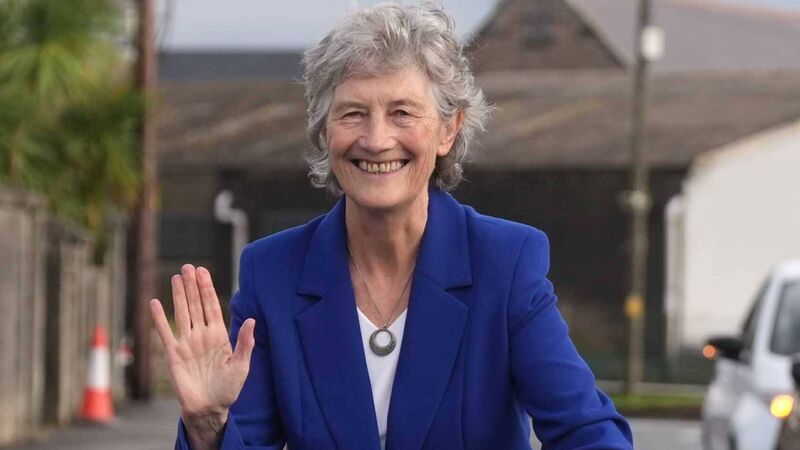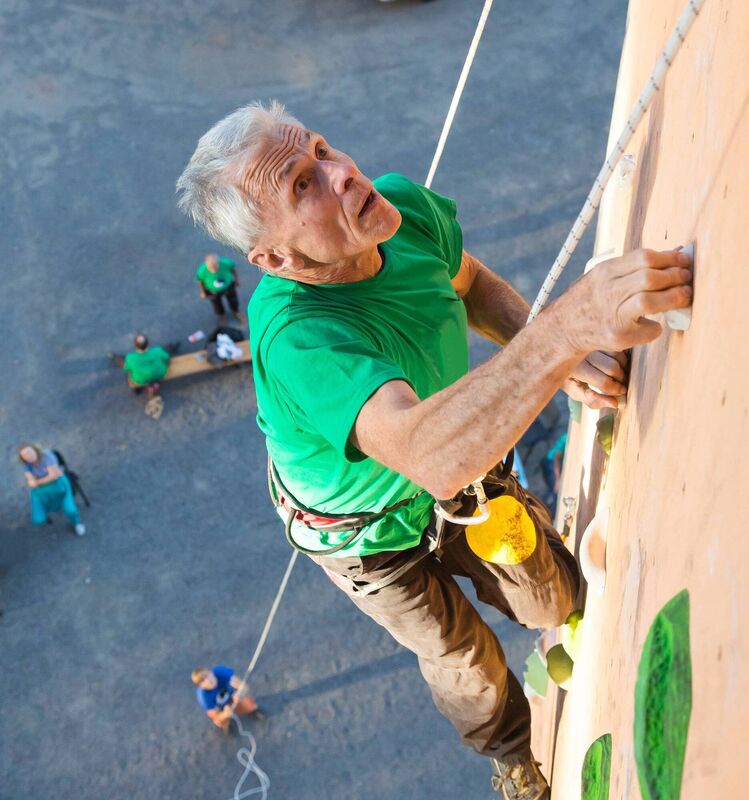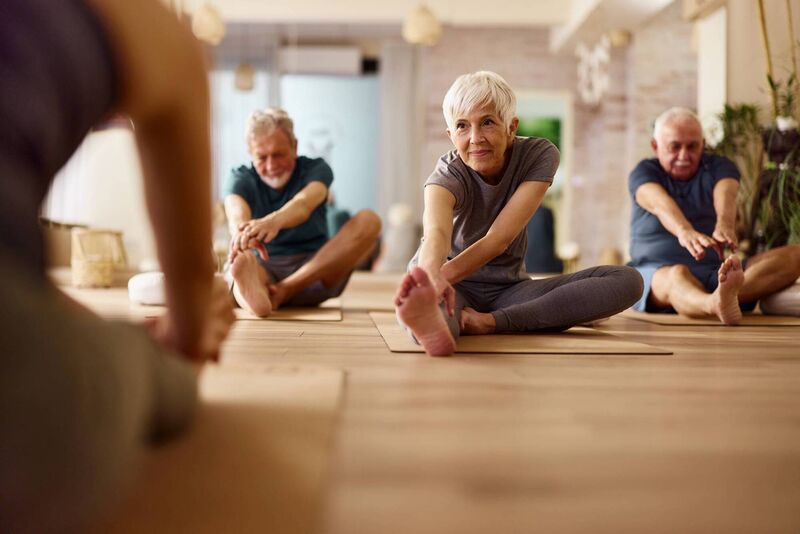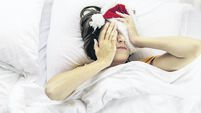How Catherine Connolly's fitness sets the standard for us to follow to age well

There’s no reason why age should be a barrier to learning a new sport or form of exercise. Picture: Brian Lawless/PA Wire
As Catherine Connolly prepares to start her seven-year presidential term, her physical stamina has already been well and truly tested on the campaign trail.
Connolly wielded a hurley and sliotar in Tipperary, took part in an aerobics class in Naas, Co Kildare, and played basketball with children on Ballybough Rd, Dublin.
Videos of her impressive keepy-uppy skills amassed millions of views on TikTok and Instagram. Last month, she arrived by bicycle to vote in the presidential election at Claddagh National School in Galway.
Her athletic prowess is impressive, and at 68, she is a glowing advertisement for the benefits of staying active and ageing well.
Experts say that remaining physically active is one of the most important things you can do to support healthy ageing.

“Catherine Connolly is a wonderful advocate for people staying fit in their 60s, 70s, and 80s,” says Niall Moyna, professor of clinical exercise physiology at Dublin City University.
“When you see a 68-year-old skilfully playing with a football as she did, it closes the chronological age barriers and makes people realise we can be fit and healthy at any age.”

National guidelines on physical activity for Ireland recommend that adults aged 18-64 engage in at least 30 minutes of activity per day or 150 minutes per week — while those over 65 should aim for a similar amount, focusing on aerobic activity, muscle-strengthening, and balance exercises.
That amount of physical activity — particularly when it is moderate-intensity and raises your heart rate — is known to reduce the risk of a number of diseases, including heart disease, stroke, diabetes, and cancer.
Yet research by the Institute of Public Health in 2023 revealed that one in seven people and 17% of over 65s in Ireland are inactive — that is, they do not engage in physical activity at all. Experts insist that an active lifestyle in your 50s, 60s, and 70s is the best way to stay healthy, avoid cognitive decline, and enhance longevity.
“Regular movement helps preserve strength, balance, and cardiovascular fitness, all of which are essential for maintaining function and independence as we age,” says Ciara McCormack, assistant professor of exercise and health at Maynooth University. “But it is also important for continuing to engage in everyday activities with confidence.”
Last year, researchers reporting in the journal provided evidence that the life-extending benefits of exercise spike after 60. In a study involving over 2m adults aged 20 to 97, the Spanish research team found that staying physically active throughout a person’s lifespan helps them live longer, with older adults reaping the most benefits in terms of added years.

Another study of 1,433 adults aged 60 and above at the University of Cambridge showed that a reduction in the amount of time spent physically active in later life is linked to a lower quality of life, highlighting the need to maintain physical activity.
Moyna says the best form of exercise is any exercise you choose to do.
“Those who get the biggest bang for their buck at any age are people who were previously sedentary and who start moving more,” he says.
“I am 66 and know the physical and emotional benefits that come with being active, which include having greater endurance and being mentally alert, which will certainly benefit Catherine Connolly when she takes office.”
And there’s no reason why age should be a barrier to learning a new sport or form of exercise.
“Don’t think of your 60s or 70s as old, but as a time of life to try something new,” Moyna says. “Go rollerblading, surfing or dancing, or do something you thoroughly enjoy, and you will reap the rewards.”

“Daily steps are important for health and something most of us can target,” Moyna says.
Aiming for at least 7,000 steps will ward off disease, whatever your age. This figure was confirmed following a large global review of 57 studies published in in July.
Melody Ding, an epidemiologist and population behavioural scientist at the University of Sydney, who headed the analysis, found that — compared to people who took 2,000 daily steps — those walking 7,000 steps saw similar health gains to clocking up 10,000 a day, with boosted heart and brain health and half the risk of early death.
“If you are well below that at the moment, start with 2,000 steps, which will bring benefits,” Moyna says. “And add more as you feel ready.”

Whenever possible, use walking or cycling — as Connolly does — to get around.
“They are a great way to integrate exercise into your daily routine,” says McCormack. “While other enjoyable activities, such as swimming or playing games and sports, add variety and fun.”
Together, these help people reach the national physical activity guidelines, which recommend at least 150 minutes of moderate-intensity aerobic activity per week.
“The key is finding activities you enjoy and can do consistently, as the physical and psychological benefits are enormous at any age,” McCormack says.
“Catherine Connolly is a great example of how staying active can support both physical and mental wellbeing as we age.”
Trying things you previously avoided at the gym because you didn’t enjoy them is a good idea as you get older. For me, at 57, it is ramping up my strength training, which I find boring but essential, and renewing my commitment to Pilates a few times a week to reduce joint-tightening so that running — my exercise of choice — remains a possibility for decades to come. I also substitute a run with a high-intensity interval bike session every three days, just to challenge my mind and muscles a little differently.
Denise Toner, 46, is an Ireland and European masters’ champion runner who added Hyrox circuit training to her regimen to reduce her risk of injury: “Hyrox has definitely helped to ward off niggles and helped to keep me at least as fit as I was in my 30s.
“It has also brought unexpected gains, such as improving good running form, and psychologically I have enjoyed the challenge of doing something very different.”

Flexibility is another aspect of fitness that nosedives as we age, and preserving it impacts more than our ability to move and stand well. I now stand up and stretch every hour to break up sitting and loosen hip tightness. A five- to 10-minute stretching routine in front of the TV is another option.
Regular stretching of large muscles in the lower body, trunk, and shoulders has been shown to improve the health of our arteries by making it easier for blood vessels to dilate, thereby reducing blood pressure over time. A study in the showed greater flexibility in middle age means you are likely to live longer compared to someone whose muscles and joints are stiff and rigid.
Research at Manchester Metropolitan University has shown balance deteriorates faster than strength as we age and that even super-fit masters athletes are not immune to the decline.
“Loss of balance is much faster than loss of muscle strength,” says Hans Degens, professor of muscle physiology. “You need to work on balance to prevent loss of balance as much as possible, so that you don’t fall and risk injury.”
At 60, Degens says he stands on one leg every day, eyes closed, aiming for at least 15 seconds.
“It’s the simplest thing you can add to your workout routine, but it has some very powerful effects,” he says.
“In lab tests, my own balance, which was terrible a few years ago, has improved to score more highly than that of my 20-year-old students with this simple approach.”

Celebrating 25 years of health and wellbeing











